#SEO Pro Tips
Explore tagged Tumblr posts
Text
The Ultimate Guide to Search Engine Optimization (SEO)
"The Ultimate Guide to Search Engine Optimization (SEO)" is a comprehensive resource that provides valuable insights and strategies for optimizing your online presence. It covers all aspects of SEO, from keyword research and on-page optimization to link building, technical SEO, and emerging trends. Whether you're a beginner looking to learn the basics or an experienced marketer seeking advanced techniques, this guide equips you with the knowledge and tools to enhance your website's visibility on search engines, drive organic traffic, and stay ahead in the ever-evolving world of SEO.

#SEO Mastery Guide#SEO Excellence Handbook#SEO Mastery Manual#SEO Success Blueprint#SEO Expert Guide#SEO Pro Tips#SEO Masterclass#SEO Essentials#SEO Domination Guide#SEO Wizardry Handbook#SEO Powerbook
0 notes
Text
8 UX Tips for Voice Search SEO
💡 Advanced SEO Pro Certification Course by Anil Varma - Registration Link in the first comment. ❤️ Follow Semly Pro - The SEO Company for more SEO tips. 🎙 Content and Design by Surya Pillai Implement these 8 UX Tips for Voice Search SEO:


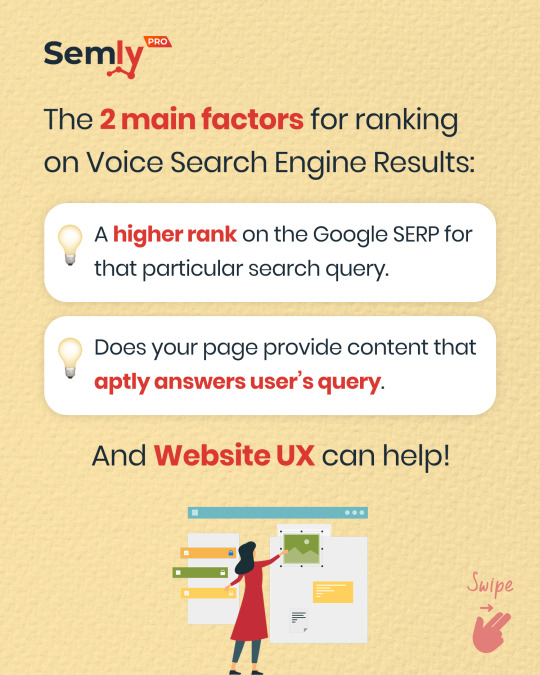
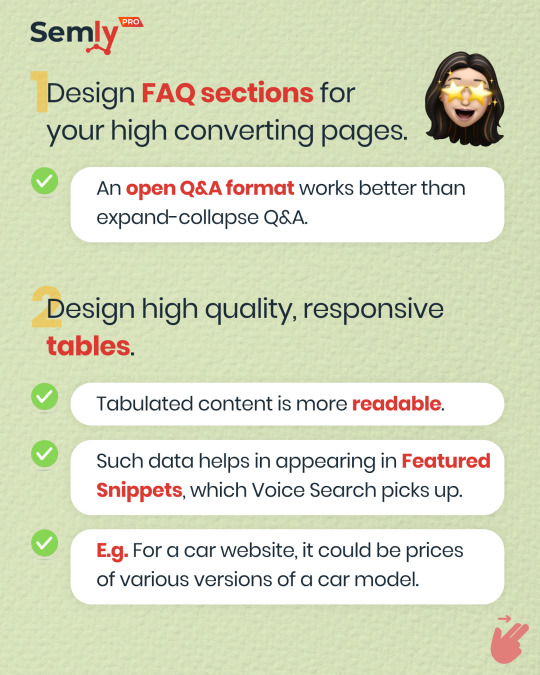
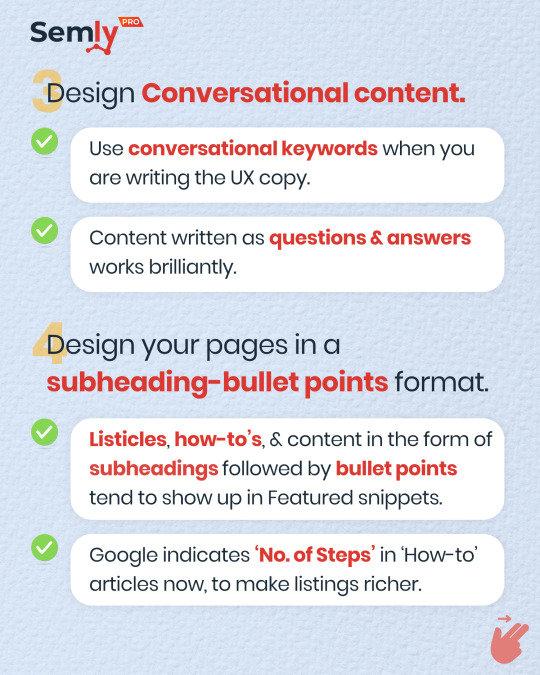
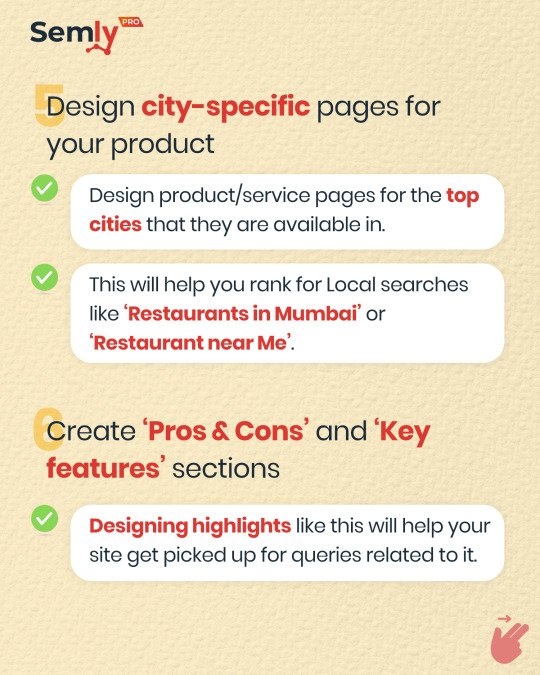
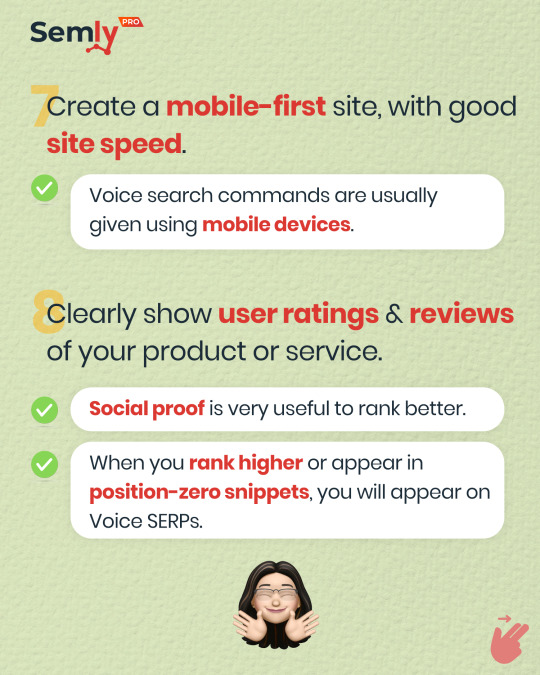
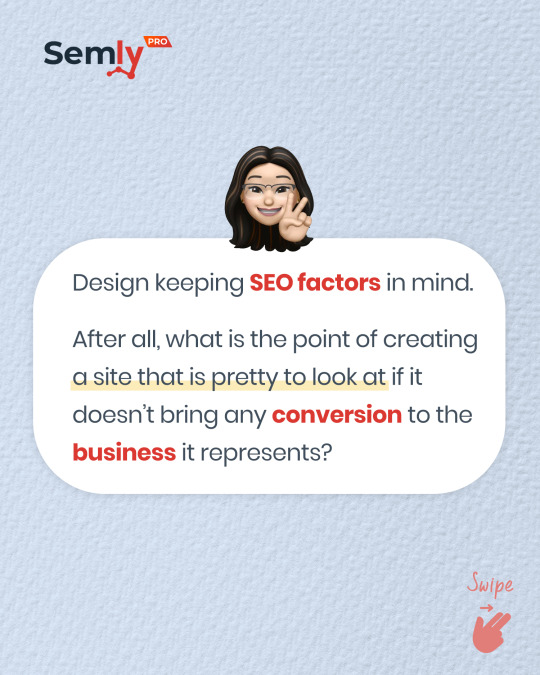
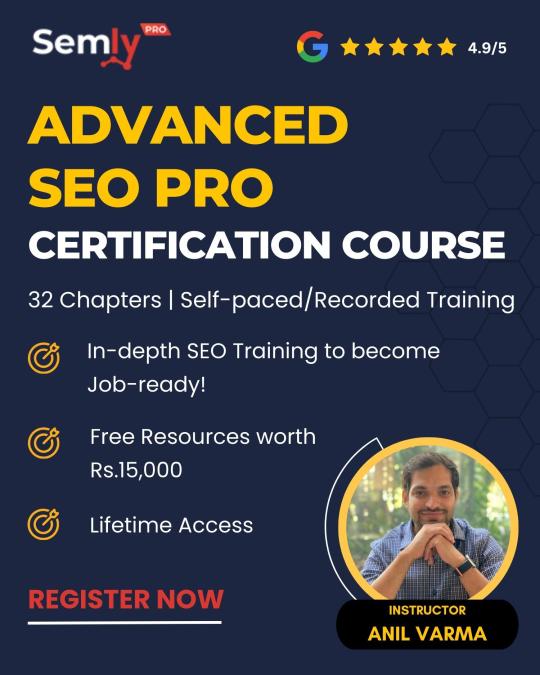
💡 Advanced SEO Pro Certification Course by Anil Varma - REGISTER NOW ❤️ Follow Semly Pro - The SEO Company for more SEO tips. 🎙 Content and Design by Surya Pillai.
#digital marketing#Digital Marketing Tips#search engine optimization#SEO#SEM#search engine marketing#ux#semly pro#semlypro#anil varma#user experience design#surya pillai#google#google search#google analytics
5 notes
·
View notes
Text
guide to keyword research that is compatible with search engines
New Post has been published on https://abnoubshenouda-digitalmarketer.com/guide-to-keyword-research-that-is-compatible-with-search-engines/
guide to keyword research that is compatible with search engines
As a business owner or marketer, you are always looking for ways to improve your website’s visibility on search engines. One way to do this is by conducting effective keyword research. Keyword research is the process of identifying the words and phrases that your target audience is using to search for products, services, or information related to your business. By incorporating these keywords into your website content, you can optimize your website for search engines and increase your chances of ranking higher in search engine results pages (SERPs).
In this article, we will provide you with a comprehensive guide to keyword research that is compatible with search engines. We will cover everything you need to know to conduct effective keyword research, including:
Why keyword research is important for SEO
How to conduct effective keyword research
Tips for choosing the right keywords
Tools to help you with keyword research
How to analyze and refine your keyword strategy
By the end of this article, you will have a solid understanding of how to conduct effective keyword research and how to use this information to improve your website’s visibility on search engines.
Why Keyword Research is Important for SEO
Keyword research is a critical component of search engine optimization (SEO). When people search for information or products online, they use specific words and phrases to find what they’re looking for. By identifying the keywords that your target audience is using, you can optimize your website content for these terms and increase your chances of ranking higher in SERPs.
Keyword research can help you in the following ways:
Helps you understand your target audience: Keyword research can provide valuable insights into what your target audience is looking for and how they are searching for it. By understanding their search behavior, you can create content that meets their needs and helps you connect with them.
Improves your website’s visibility: By incorporating relevant keywords into your website content, you can increase your chances of ranking higher in search engine results pages (SERPs). This can help you attract more traffic to your website and increase your brand’s visibility online.
Enhances your content strategy: Keyword research can help you identify topics that are relevant to your target audience and create content that addresses their needs. This can help you establish your brand as an authority in your industry and build trust with your target audience.
How to Conduct Effective Keyword Research
Effective keyword research involves several steps. Here’s a step-by-step guide to help you get started:
Step 1: Brainstorm Keywords
The first step in keyword research is to brainstorm keywords related to your business or industry. Think about the products or services you offer, the topics you cover, and the questions your target audience might have. Make a list of these keywords and phrases.
Step 2: Analyze Keyword Data
Once you have a list of potential keywords, it’s time to analyze the data to determine their search volume and competition level. There are several keyword research tools available that can help you with this, including:
Google Keyword Planner: This is a free tool that allows you to see the estimated search volume and competition level for specific keywords.
SEMrush: This is a paid tool that provides in-depth keyword analysis, including keyword difficulty, search volume, and competitor analysis.
Ahrefs: This is another paid tool that provides detailed keyword data, including search volume, keyword difficulty, and competitor analysis.
Using one of these tools, you can enter your list of keywords and analyze the data to determine which ones are most relevant to your business and have the highest search volume.
Step 3: Prioritize Keywords
Once you have analyzed the keyword data, it’s time to prioritize your keywords. Focus on the keywords with the highest search volume and relevance to your business. These are the keywords that your target audience is searching for and that are most likely to drive traffic to your website.
Step 4: Refine Your Keyword List
Now that you have prioritized your keywords, it’s time to refine your list. Remove any keywords that are not relevant to your business or have low search volume. You should also consider the competition level for each keyword. Highly competitive keywords may be difficult to rank for, so it’s important to focus on keywords with a moderate level of competition.
Step 5: Analyze Competitor Keywords
It’s also important to analyze your competitors’ keywords. Identify your top competitors and analyze their website content to see what keywords they are targeting. This can help you identify new keywords to target and refine your existing keyword list.
Tips for Choosing the Right Keywords
Choosing the right keywords is essential for effective keyword research. Here are some tips to help you choose the right keywords for your business:
Use Long-Tail Keywords: Long-tail keywords are longer, more specific phrases that have less competition than shorter, more general keywords. They are often easier to rank for and can attract more qualified traffic to your website.
Consider Search Intent: When choosing keywords, consider the search intent behind them. Are people searching for information, products, or services? By understanding the search intent, you can create content that meets your target audience’s needs and drives conversions.
Use Local Keywords: If you have a local business, be sure to include local keywords in your keyword research. This can help you attract more local traffic to your website and improve your local search rankings.
Use Keyword Variations: Use different variations of your keywords to attract more traffic to your website. For example, if your main keyword is “SEO,” you could also target variations like “search engine optimization” or “SEO services.”
Tools to Help You with Keyword Research
Keyword research can be time-consuming, but there are several tools available that can help you streamline the process. Here are some of the best keyword research tools to consider:
Google Keyword Planner: This free tool provides keyword ideas, search volume data, and competition level for specific keywords.
SEMrush: This is a paid tool that provides in-depth keyword analysis, including keyword difficulty, search volume, and competitor analysis.
Ahrefs: This is another paid tool that provides detailed keyword data, including search volume, keyword difficulty, and competitor analysis.
Moz Keyword Explorer: This is a paid tool that provides keyword suggestions, search volume data, and keyword difficulty.
Ubersuggest: This is a free tool that provides keyword ideas, search volume data, and competition level for specific keywords.
How to Analyze and Refine Your Keyword Strategy
Keyword research is an ongoing process. Once you have implemented your keyword strategy, it’s important to regularly analyze and refine it to ensure it’s still effective. Here are some tips to help you analyze and refine your keyword strategy:
Monitor Your Rankings: Use a tool like Google Analytics or SEMrush to monitor your keyword rankings. This can help you identify keywords that are driving traffic to your website and those that need more attention.
Identify New Keyword Opportunities: Regularly review your website content and identify new keyword opportunities. Use keyword research tools to determine the search volume and competition level for these new keywords.
Analyze Competitor Keywords: Keep an eye on your competitors and analyze their keyword strategy. Identify new keywords to target and refine your existing keyword list.
Update Your Content: Regularly update your website content to include new keywords and ensure it remains relevant and useful to your target audience.
Conclusion
Keyword research is an essential component of search engine optimization. By identifying the keywords your target audience is using, you can optimize your website content and improve your chances of ranking higher in SERPs. Follow the
steps outlined in this guide to conduct effective keyword research for your business:
Start with a seed list of keywords.
Use keyword research tools to expand your list.
Prioritize your keywords based on relevance, search volume, and competition level.
Refine your list by removing irrelevant keywords and focusing on moderately competitive keywords.
Analyze your competitors’ keyword strategy to identify new keywords to target.
Remember to choose the right keywords for your business, using long-tail keywords, considering search intent, using local keywords, and using keyword variations. Use keyword research tools like Google Keyword Planner, SEMrush, Ahrefs, Moz Keyword Explorer, and Ubersuggest to streamline your keyword research process.
Once you have implemented your keyword strategy, regularly analyze and refine it to ensure its effectiveness. Monitor your keyword rankings, identify new keyword opportunities, analyze competitor keywords, and update your content regularly.
Effective keyword research can help you drive more traffic to your website and improve your search engine rankings. By following the steps outlined in this guide, you can conduct effective keyword research and develop a keyword strategy that works for your business.
read also
The Basics of Search Engine Optimization (SEO)
Why SEO is Essential for Your Digital Marketing Strategy
Maximizing Your ROI: The Science of Pay-Per-Click Advertising
#ahrefs keyword research#best keyword research#c keyword auto#content strategy#digital marketing#keyword research#keyword research and analysis#keyword research and analysis in digital marketing#keyword research basics#keyword research benefits#keyword research best tools#keyword research by neil patel#keyword research complete guide#keyword research definition#keyword research seo#keyword research tips#keyword research tool google#keyword researcher pro#paid advertising#seo best practices#target audience#what is keyword research#why do keyword research#why is keyword research important#SEO
2 notes
·
View notes
Text
How to Establish Your Copywriting Brand Values
Your copywriting brand values are more than just words on paper; they are the heart and soul of your business, serving as the compass that guides every decision, action, and interaction. #CopywritingTips #CopywritingValues #CopywritingMentoring
Fellow copywriter, welcome to the exciting world of professional copywriting. Taking your first steps on setting up your own copywriting brand and agency could be a little bit intimidating but fear not. We’ve been there and have done that long hours working, month after month… Let me tell you what I wish I had known when I first started my SEO Copywriting Agency journey: Define Your Copywriting…

View On WordPress
#Copywriting Agency in Greece#Copywriting Coaching#Copywriting Guides#Copywriting Mentoring#Copywriting Pro Tips#Copywriting Questionnaire#Copywriting Tips#Copywriting Values#SEO Copywriting Agency
0 notes
Text
Create a Stunning Website on WordPress Using Elementor
In the digital age, establishing an appealing and functional website is essential for individuals and businesses alike. WordPress, in conjunction with Elementor and Elementor Pro, offers a user-friendly platform to create stunning websites without the need for extensive coding knowledge. This step-by-step guide will walk you through the process of creating a captivating website using WordPress…

View On WordPress
#Blogging for Beginners#Blogging Tips#Blogs#Content Marketing#Digital Marketing#E-commerce#Elementor#Elementor Pro#Keyword Research#Online Business#Responsive Design#Search Engine Optimization#SEO Optimization#talkstreetblog#User Experience (UX)#Web Development#Website Building#Website Design#Website Hosting#Wordpress#WordPress Plugins#WordPress Themes
0 notes
Text
google favourite SEO-friendly writing tips
10 guidelines for SEO content writing
Research and understand your audience.
Satisfy your keyword's search intent.
Include related keywords in your content.
Add secondary keywords to your subheadings.
Write compelling headlines.
Include target keywords in the metadata.
Implement internal and external linking.
Create content hubs.
Rewrite and update the content.
Measure your content's performance.

Developing brands. Upgrading the content.
content that we provide: • Website contents • Translation services • Blog writing services • Product descriptions • Article writing
Mail id: [email protected] Call us at 9990084440. website: http://https://www.transcurators.com/ Visit here: https://www.transcurators.com/content-service ~ Thank you .
#content writing services#content writing#content writing tips#google seo-friendly content writing tips#10 pro tips for seo-content writing#pro tips for blog ranking factor#seo-friendly content writing#content creation#content writing tips for google ranking
0 notes
Text
https://www.dizitalmedia.com/how-to-develop-a-business-online/
Want to Develop Business Online ?
Follow the 10 Pro Tips
0 notes
Text
🎉 Exciting News! 🎉 Introducing the WordHero Group Buy! 📚🔍 Are you ready to take your word game skills to the next level? Join our exclusive group buy and get access to the ultimate WordHero toolkit at an unbeatable price! 🙌💥
🧵 Here's what you get in this amazing offer:
1️⃣ WordHero Pro Membership 🏆 Unlock all the advanced features and power up your gameplay. Get access to unlimited hints, ad-free experience, and exclusive word lists. Become a true WordHero!
2️⃣ Exclusive Word Packs 📚 Expand your vocabulary and challenge yourself with our premium word packs. From sports to science, we've got you covered! 🤓🔍
3️⃣ Weekly Challenges 🏅 Put your skills to the test and compete with other WordHeroes in our weekly challenges. Earn special rewards and bragging rights among your friends! 💪🌟
4️⃣ Expert Tips and Strategies 🧠 Learn from the best! Get exclusive access to our WordHero experts who will share their tips, tricks, and strategies to help you dominate the game. 🎯🔥
5️⃣ Community Support 🤝 Join our vibrant WordHero community and connect with fellow word game enthusiasts. Share your achievements, seek advice, and make new friends along the way. 🌐❤️
Don't miss out on this incredible opportunity to enhance your word game experience! 🚀 Join the WordHero Group Buy now and become the ultimate WordHero! 💯
Limited spots available, so act fast! ⏰ Click the link in our bio to sign up and secure your spot today. Happy word hunting! 🕵️♀️🔠 #WordHeroGroupBuy #UnleashYourWordPower
Visit : 👉Janet Jackson Seo || Digital Marketer & Seo Expert

65 notes
·
View notes
Text

YouTube Educational Resources: Learn, Apply, and Take Your Channel to the Top!
Being successful on YouTube isn’t just about standing in front of a camera and hitting record, right? True success comes from smart strategies and continuous learning. That’s exactly where YouTube Educational Resources come into play!
Free tools like YouTube Creator Academy provide creators with essential guidance on growing their channels, mastering SEO strategies, and improving video production. But how can you make the most of these resources?
Let’s say you’ve created a video, carefully chosen the title, and hit upload. But… the views buy YouTube views aren’t coming in as expected. YouTube Educational Tools help you analyze why your video isn’t performing well and guide you toward better results.
In these resources, you’ll learn how to:
Create attention-grabbing titles and descriptions for your videos.
Choose SEO-friendly tags to boost search visibility.
Keep your audience engaged and watching your videos for longer durations.
Additionally, you’ll gain a better understanding of how algorithms work, allowing your videos to reach a wider audience. By staying updated with the latest trends and best practices shared by YouTube, you can consistently improve your channel’s performance.
Pro Tip: While watching these educational videos, take notes and immediately apply what you’ve learned to your next video. Even small changes can have a huge impact on your view counts buy YouTube views and audience engagement.
YouTube isn’t just a platform for uploading videos it’s a space for creators to learn, grow, and thrive. The more you invest in improving your skills and knowledge, the clearer the results will be in your channel’s performance.
Remember: Success begins with the right knowledge. Stay curious, refine your strategies, and make a difference on YouTube!
#influencer#buy youtube views#youtuber#youtube#youtube video#youtube views#ssmarket#across the spiderverse#ace attorney#academia#animation
3 notes
·
View notes
Text
Attention Fitness Coaches & Personal Trainers!
🚨 Struggling with Local SEO? You’re Not Alone! 🚨
Building your fitness business online is tough — but it doesn’t have to be. Let’s tackle the 3 Most Common Local SEO Challenges that fitness coaches and personal trainers face:
1️⃣ Inconsistent Business Listings
📍 Mismatched addresses or phone numbers across directories confuse search engines . Keep your NAP consistent everywhere.
2️⃣ Weak Google Business Profile
⭐ Reviews and updated posts on your Google Business Profile (GBP) are critical. A neglected GBP means fewer local clients finding you.
3️⃣ Low-Quality Backlinks
🔗 Your website needs links from reputable local sources (e.g., gyms, wellness blogs). Without these, search engines won’t see your site as trustworthy.
💡 Pro Tip: Optimize your website with localized keywords like “personal trainer in [City Name].” Focus on mobile-friendly design for those on-the-go searches!
💪 It’s Time to Dominate Your Local Market!
With the right local SEO strategy, you can attract more clients and grow your fitness business. Need help? Let’s connect!
#LocalSEO #FitnessCoaches #PersonalTrainers #DigitalMarketing #SEOForFitness
#genshin impact#deltarune#disco elysium#call of duty#obey me#ffxiv#seo services#fnaf#on page seo#ace attorney
2 notes
·
View notes
Text
How to Create Designs That Work for Your Print-on-Demand Business
Running a print-on-demand business is both exciting and challenging. Whether you're selling on platforms like Redbubble or managing your own store, creating designs that resonate with your audience is the key to success. But how do you craft designs that not only look great but also sell? In this blog post, I’ll guide you through the process of creating designs that work for your print-on-demand business, with tips and tricks tailored to help you stand out in a competitive market. Let’s dive in!
Why Design Matters in Print-on-Demand
In the world of print-on-demand, your designs are your product. Unlike traditional retail, you’re not selling physical inventory—you’re selling ideas. Your customers are drawn to your creativity, so your designs need to:
- Capture attention: Bold, unique designs stand out in search results.
- Resonate with your audience: People buy designs that align with their personality, values, or interests.
- Fit the product: A design that looks great on a t-shirt might not work on a mug or phone case.
Understanding these principles is the first step to creating designs that work for your business.
Step 1: Know Your Niche
The most successful print-on-demand businesses are niche-focused. Instead of trying to appeal to everyone, target a specific audience.
- Research your audience: Who are they? What are their interests, hobbies, or values?
- Find trending niches: Use tools like Google Trends or Redbubble’s trending searches to discover what’s popular.
- Create for your passion: If you’re passionate about your niche, it will show in your designs.
For example, if your niche is cozy, minimalist designs, you could create products that appeal to people who love hygge-inspired aesthetics.
Step 2: Brainstorm Unique Design Ideas
Once you’ve identified your niche, it’s time to brainstorm ideas. Here’s how to get started:
- Use keyword research: Tools like Redbubble’s search bar or Pinterest Trends can help you find popular themes.
- Look for inspiration: Check out competitors, social media, or even nature for fresh ideas.
- Think seasonally: Holidays, seasons, and special events are great opportunities for themed designs.
Pro tip: Keep a notebook or digital folder for design ideas. Inspiration can strike at any time!
Step 3: Master the Tools of the Trade
You don’t need to be a professional graphic designer to create stunning designs. With the right tools, anyone can make high-quality artwork.
- Free design tools: Canva, GIMP, and Inkscape are great for beginners.
- Professional software: Adobe Photoshop and Illustrator offer advanced features for experienced designers.
- Mockup generators: Use tools like Placeit to see how your designs will look on products.
If you’re new to design, start simple. Minimalist designs with clean lines and bold typography are often bestsellers.
Step 4: Optimize Your Designs for Products
Not all designs work on every product. To maximize sales, tailor your designs to fit specific items.
- Consider placement: A design that looks great on a t-shirt might need adjustments for a mug or sticker.
- Use high-resolution files: Print-on-demand platforms require high-quality images to ensure sharp prints.
- Test your designs: Upload them to mockup tools to see how they look on different products.
For example, if you’re creating a design for a phone case, make sure the key elements aren’t cut off by the edges or camera hole.
Step 5: Write SEO-Friendly Titles and Tags
Even the best designs won’t sell if no one can find them. That’s where SEO comes in.
- Use relevant keywords: Include terms your audience is searching for, like “minimalist phone case” or “funny coffee mug.”
- Write descriptive titles: Instead of “Cool Design,” try “Retro Sunset Design for T-Shirts and Stickers.”
- Add detailed tags: Use a mix of broad and specific tags to improve your visibility.
For example, if your design is a cozy winter illustration, your tags might include “winter mug,” “cozy vibes,” and “holiday gift ideas.”
Step 6: Promote Your Designs
Creating great designs is only half the battle—you also need to market them.
- Leverage social media: Share your designs on Instagram, Pinterest, and TikTok.
- Engage with your audience: Respond to comments and messages to build a loyal following.
- Collaborate with influencers: Partner with creators who align with your niche to reach a wider audience.
You can share behind-the-scenes content, like your design process or mockups, to connect with your audience on a personal level.
Step 7: Analyze and Improve
Finally, track your performance to see what’s working and what’s not.
- Check your analytics: Platforms like Redbubble provide insights into your sales and traffic.
- Experiment with new designs: Test different styles, themes, or niches to see what resonates.
- Listen to feedback: Pay attention to customer reviews and comments to improve your designs.
Remember, success in print-on-demand is a marathon, not a sprint. Keep learning and adapting as you go.
Final Thoughts
Creating designs that work for your print-on-demand business takes time, creativity, and strategy. By understanding your niche, mastering design tools, and optimizing your listings for SEO, you can build a successful shop that stands out from the crowd.
You have the power to turn your ideas into products that people love. So, what are you waiting for? Start creating today and watch your business grow!
Looking for unique, cozy designs that inspire and stand out? Visit my Redbubble shop to explore a collection of creative products made just for you!
#Print-on-demand business#Redbubble tips#How to create designs#Print-on-demand design tips#Redbubble design ideas#Niche marketing for POD#How to sell on Redbubble#Print-on-demand success#Redbubble SEO tips#Best tools for POD#Graphic design for beginners#Trending print-on-demand niches#How to optimize designs#Print-on-demand marketing#Redbubble product ideas#Cozy design inspiration#Minimalist design tips#Seasonal design ideas#How to use Canva for POD#Redbubble mockup tips#Passive income with POD#How to sell art online#Redbubble shop strategies#Print-on-demand trends#How to grow a POD business#Print-on-demand branding#Redbubble keyword research#Social media for POD#Redbubble artist tips
2 notes
·
View notes
Text
Keyword Research explained in simple words with an example by Semly Pro
💡 Keyword Research explained in simple words with an example. 💡 Advanced SEO Pro Certification Course - Registration NOW!



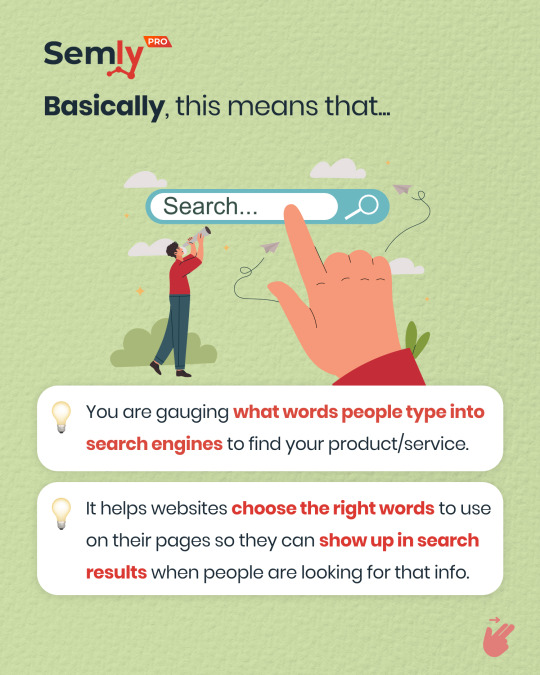


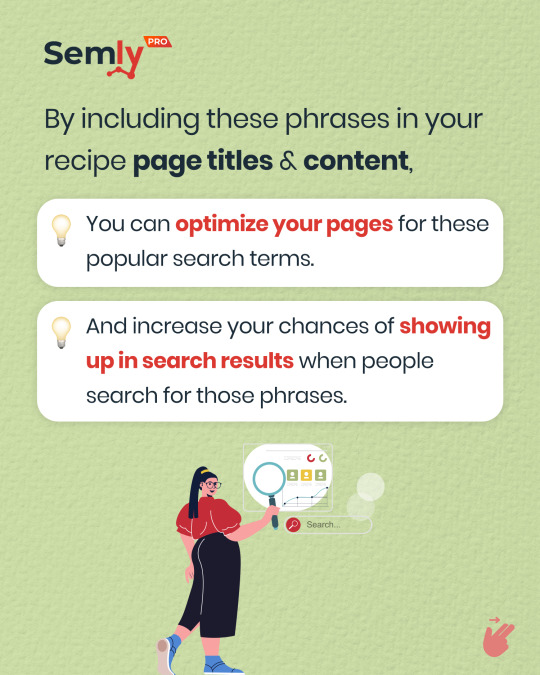
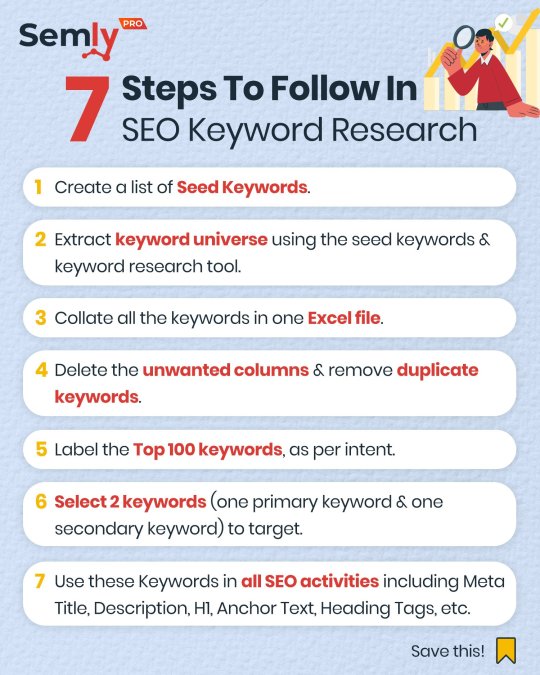
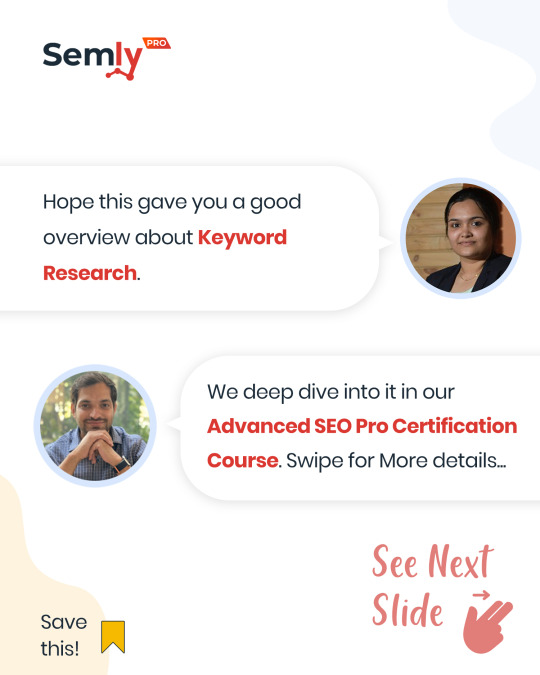
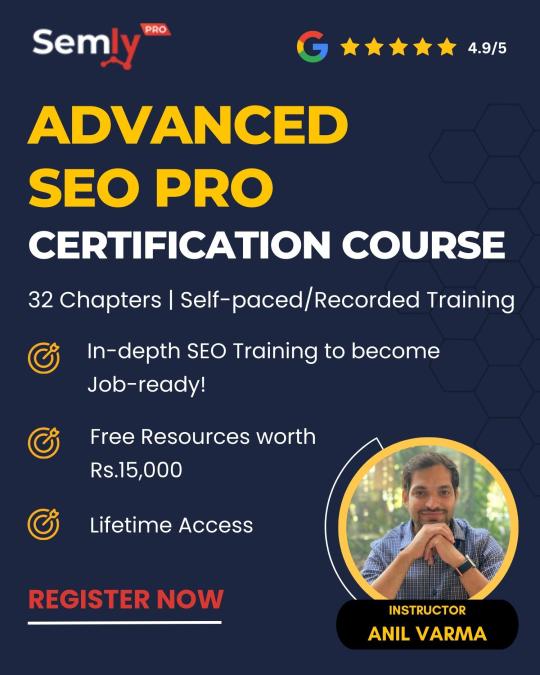
❤️ Register for the SEO course on - Semly Pro - The SEO Company
🎙 Content by Surya Pillai and Anil Varma. ❤️ Design by Surya Pillai.
#SEO#search engine optimization#search engine marketing#SEM#Keyword research#digital marketing#seo course#Digital Marketing Tips#semly pro#surya pillai#anil varma
4 notes
·
View notes
Text
How to build your own SEO ‘second brain’ (and why you need it)
Whether you’re an internal SEO whiz or a digital agency pro, chances are you’ve experienced one or more of these all-too-familiar problems:
Feeling drowned in an ocean of ever-evolving industry trends.
Spending forever in the set-up phase, building deliverable trackers, audit sheets, keyword map templates, content briefs, and backlog grooming can feel like you’re on a never-ending treadmill.
Yes, I’ve been there too. I felt the relentless churn and knew that something had to shift dramatically if I wanted to continue growing as an SEO.
This realization led me to discover the game-changing concept of building a “second brain,” an idea popularized by Tiago Forte.
I’ve since applied this concept to my own SEO practices. Below, I’ll cover how you can build your own SEO second brain.
Why you should consider building an SEO second brain
Before building a second brain, let’s examine what an organic brain excels at and where it falls short. Here’s a quick snapshot:
Our brains are great at:
Generating original ideas.
Interconnecting ideas and spinning compelling narratives.
Fostering empathy with others.
But terrible at:
Retaining information over a prolonged period.
Segmenting and categorizing stored data.
Retrieving and applying stored information.
By delegating the latter tasks to an external database or a “second brain,” you can better store and retrieve crucial documentation, templates, and key learnings between websites.
Most importantly, never again will you forget crucial information when you most need it.
How to start building your own SEO second brain
Building your second brain may seem daunting initially, but take it one step at a time, and you’ll get there. Start with the following steps and tips:
Selecting the right tools to suit the way you work
Structuring your second brain with the PARA system
Operating your second brain: Start with idea capturing
A quick walkthrough of my own SEO second brain
You can use plenty of systems and platforms to build a second brain. It all comes down to your preference and which platform you’re most comfortable with.
I use Notion to build my SEO second brain (and operate most of my SEO projects), so I’ll use examples from Notion throughout this article.
A great way to identify which tool to use for building your SEO second brain is to get to know your style of information organization. Here are some examples Forte mentions:
The architect: Prefers systematizing information in a hierarchical manner, focusing on large-scale projects and using a systems mindset. They have to be careful not to force information into their system when it doesn’t fit. Apps like Notion and Craft are well-suited to this style.
The gardener: Thrives on cultivating many ideas at the same time, favoring relationships and connections. They must beware of getting easily distracted by new, unrelated information. Apps like Obsidian and Roam are well-suited to this style.
The librarian: Practical and project-oriented, they like to capture information from diverse sources and curate a collection of knowledge. Their pitfall might be amassing content without using it. Apps like Evernote and Microsoft OneNote are well-suited to this style.
The student: Usually new to knowledge management or focusing on a specific part of their life. They favor ease of use and avoid complexity. Apps like Apple Notes or Google Keep are well-suited to this style.
Structuring your second brain with the PARA system
The PARA system stands for:
Projects: Specific tasks linked to a goal or deadline.
Areas: Responsibilities that need to be maintained over time.
Resources: A topic or theme of ongoing interest.
Archives: Inactive items from the other three categories.
Here are some examples of which SEO tasks suit each category.
Projects: Your most important and time-sensitive tasks.
Example: Optimize the internal linking structure for a core landing page by the end of the week.
Areas: Your ongoing optimization efforts and routine tasks.
Example: Create monthly performance reports.
Resources: Shared credentials and background information.
Example: CMS logins and target personas.
Archives: Completed tasks and documentation
Example: Title tags updated over the past 24 months.
I’ve adopted some version of the PARA framework to manage SEO campaigns for 35+ websites.
It’s a game-changer to help me get the most impactful tasks done first and still deliver on smaller issues.
But how does this help me better manage SEO projects?
Traditionally, SEOs tend to structure our work into static categories like keyword research, technical audit, link building, and content production. However, this doesn’t mirror the dynamic nature of SEO projects.
This conventional and static way of organizing information is like categorizing your kitchen by individual ingredients rather than usage and priority (a fun analogy credited to Forte).
Wouldn’t it be odd to organize your kitchen by carrots, potatoes, and fruits rather than stovetop items, pantry goods, and fridge contents?
Like kitchens, static file structures can lead to “cross-contamination” between outdated and fresh documents, making it challenging to locate the most relevant information quickly.
Enter the PARA framework – a dynamic solution reflecting the shifting priorities of an SEO project:
Immediate concerns reside in the Project folder.
Ongoing work belongs to the Area folder.
Thematic and research material is kept in the Resources folder.
Completed tasks and old data go into the Archives folder.
This way, PARA keeps your SEO project fluid, organized, and current.
Operating your second brain: Start with idea capturing
Let’s say you’ve built an SEO second brain of your own. How do you go about using it in the best way possible?
For me, it’s all about idea capturing. This is the act of quickly and effortlessly storing information you’ve encountered throughout the day in a temporary repository.
It’s the single most important mechanism to master in operating a second brain.
That’s because it enables me to quickly and passively store new information in a temporary space of my second brain so that I can later revisit and move it to relevant sections of the brain.
These can include:
Important algorithm or industry updates.
Interesting articles on new tactics I can apply to my own websites.
Add meeting notes and recordings throughout the day.
Insightful conversations I’ve had with my colleagues.
I’ve built an empty page in my second brain called the Idea Capturing Station, meant to do just this, keeping it immediately accessible to me at all times on both desktop and mobile.
Here’s an example of how I quickly capture an interesting article on desktop:
And here’s how I quickly capture a new idea on mobile:
A quick walkthrough of my own SEO second brain
Here’s a quick snapshot of what my SEO second brain dashboard looks like.
Each of these individual areas, like Project Timeline, is then linked to separate databases where I store and organize information hierarchically. That’s right. I’m a classic architect when it comes to information organization.
In reality, however, I rarely use this dashboard. I use the tool’s internal search function to find specific areas of my second brain I want to navigate to.
For instance, if I’d like to find one of my project timelines, I can search for it and hop straight to it like so.
Building reusable templates
One of the most useful “powers” of this second brain is its ability to create reusable templates, giving me an almost instant set-up each time we onboard a new client at my agency.
With just a few clicks, I am able to populate a full SEO roadmap timeline, each broken into tickets with specified templates to be delegated to team members and shared with clients. Here are a few examples:
Keyword mapping
Content production
Documentation at hand
What about that time you forgot a key piece of information or statistic while meeting with stakeholders?
I have a database called the Knowledge Bank that allows me to pull up key information to reference at all times.
Let’s say I’m trying to convince some stakeholders that it can be worthwhile pursuing keywords with “zero search volume.”
In the middle of the conversation, I vaguely recall having read an article by Steve Toff on discovering zero search volume keywords, showing strong evidence of their ROI potential.
In this case, I can quickly search for the article on my second brain and reference the article almost instantly.
How to make the most of your second brain? Exercise it!
My second brain is far from complete and probably always will be (very much like our organic brains!).
The key here is to exercise our SEO second brain regularly so that we get better at using it to store, retrieve and synthesize information.
Once you’re familiar, extend your second brain to other domains of life!
Our second brain goes far beyond SEO at Criclabs, the digital agency I’m running. We use it to track new hires, document company processes, run employee portals and more.
The good news is many of us already have an SEO second brain in the works, whether we know it or not. If you have a shared drive to store information or occasionally take notes on your phone, your SEO second brain is already on its way.
What you can do now is what we SEOs know best, optimize it!
Opinions expressed in this article are those of the guest author and not necessarily Search Engine Land. Staff authors are listed here.
Add Search Engine Land to your Google News feed.
Related stories
New on Search Engine Land
<![CDATA[ @media screen and (min-width: 800px) #div-gpt-ad-3191538-7 display: flex !important; justify-content: center !important; align-items: center !important; min-width:770px; min-height:260px; @media screen and (min-width: 1279px) #div-gpt-ad-3191538-7 display: flex !important; justify-content: center !important; align-items: center !important; min-width:800px!important; min-height:440px!important; ]]>
About the author
Toon is an organic growth expert and co-founder of Criclabs, a digital agency based in Bangkok. He's worked with global brands like Electrolux, Greenpeace, and a multitude of startups deliver organic growth to their digital products.
Read more here https://sites.google.com/view/gorilladigitalseo/home
3 notes
·
View notes
Text
Digital Marketing.
💡 What is Digital Marketing? Digital marketing is not just about advertising or social media posts. Digital marketing is a dynamic, advanced strategy that connects brands with their audiences through online channels like search engines, email, social platforms, and more. 🚀
📈 Why it matters Global Reach: Your business is no longer limited. Digital marketing will reach customers all over the world! 🌍 Cost-effective: You have to spend wisely and in the right way. Nothing is difficult. Digital marketing is significantly cheaper than traditional advertising methods. Data-driven: With data analytics, you can see at any time what works, what doesn’t, and adjust in real-time. 📊 🔥 Top Trends of 2024 AI-powered campaigns: Say hello to smart targeting and personalized content. Interactive content: Quizzes, polls, and AR experiences are stealing the spotlight. Voice Search Optimization: With voice assistants on the rise, this is a must. 💬 Pro Tip for Beginners Start small but be consistent. Choose a platform where your audience hangs out (like Instagram or LinkedIn) and build a presence there before expanding.
💻 Digital marketing isn’t just a trend; it’s a necessity. Whether you’re a seasoned pro or just starting out, there’s always room to learn and innovate. So, let’s keep pushing the boundaries and making connections that matter! 💪
Contact us to learn more and get digital marketing consultancy.
2 notes
·
View notes
Text
Fostering Success Through Aligned Values Inside Your Team
Have we ever told you what lies at the heart of what we do here at IDEADECO SEO Copywriting Agency? #CopywritingValues #SEOcopywriting #CreatorEconomy #SEOcopywritingagency
Have we ever told you what lies at the heart of what we do here at IDEADECO SEO Copywriting Agency? The time has come to introduce you to the pillar values of our copywriting culture and practices. In other words, how we keep aligned our copywriting values & quality inside our teams, no matter where they are located. One thing is for sure, we have one top principle: quality is always over…

View On WordPress
#About 2023#Areti Vassou#Copywriting Agency in Greece#Copywriting Pro Tips#Copywriting Tips#Copywriting Values#IDEADECO SEO Copywriting Agency#SEO Copywriter in Greece#SEO Copywriters#SEO Copywriting Agency
0 notes
Text
Keyword Research for SEO: What It Is & How to Do It

What is Keyword Research for SEO?
Keyword research for SEO is the foundation of any successful digital marketing services in Delhi strategy. It involves identifying the terms and phrases your target audience uses when searching online. By focusing on the right keywords, businesses can increase their visibility on search engines, attract qualified leads, and improve overall website performance.
Why is Keyword Research Important?
Increased Visibility: Proper keyword research ensures your website ranks higher in search engine results.
Better Targeting: By understanding user behavior, you can create content that aligns with what your audience is searching for.
Optimized Content Strategy: Keywords help shape your blog topics, landing pages, and ad copy.
Competitive Advantage: Analyzing your competitors' keyword strategies can refine your own approach.
For businesses like iWrite India offering digital marketing services in Delhi, this can be a game-changer in reaching potential clients locally and globally.
How to Conduct Keyword Research for SEO
Step 1: Understand Your Goals
Start by defining your objectives. Are you aiming for more traffic, leads, or conversions? Your keyword research strategy should align with these goals.
Step 2: Brainstorm Keyword Ideas
Think of potential search terms your audience might use. For example, someone looking for digital marketing services in Delhi might also search for "SEO agency in Delhi" or "social media management."
Step 3: Leverage the Best Keyword Research Tools
To refine your ideas, use tools that provide detailed insights:
Google Keyword Planner: Understand search volumes and competition.
Ahrefs: Analyze competitor keywords and backlinks.
SEMrush: Get a comprehensive view of trends and traffic potential.
Ubersuggest: Generate additional keyword suggestions.
AnswerThePublic: Discover questions people commonly search for.
Pro Tip: Long-tail keywords such as “best keyword research tool for beginners” have lower competition but higher conversion potential.
Step 4: Evaluate Keyword Metrics
When analyzing keywords, focus on:
Search Volume: How many people are searching for this term?
Keyword Difficulty (KD): How competitive is it to rank for this keyword?
Cost Per Click (CPC): Essential if you’re running PPC campaigns.
Search Intent: Is the user looking for information, a product, or a service?
Step 5: Map Keywords to Content
Once you’ve selected your keywords, assign them to specific pages or blog posts. For instance, use “keyword research for SEO” as the main focus for this blog while naturally integrating secondary keywords like “best keyword research tool” into appropriate sections.
Step 6: Prioritize Local SEO
If you're targeting a specific location, such as digital marketing services in Delhi, include location-based keywords in your content, meta descriptions, and headings.
Step 7: Continuously Update Your Keyword Strategy
SEO is not a one-time effort. Regularly revisit your keyword list and adapt to changing trends or search behaviors.
Top Tools for Effective Keyword Research
Google Keyword Planner: Great for beginners, offering search volumes and related keywords.
SEMrush: A powerful tool for tracking competitors and uncovering new opportunities.
Ahrefs: Provides in-depth insights into backlinks, keywords, and site audits.
Moz Keyword Explorer: User-friendly, with detailed keyword suggestions.
These tools ensure that your keyword strategy remains accurate and effective, whether you're optimizing content or running campaigns for digital marketing services in Delhi.
Keyword Research Made Easy
Keyword research for SEO is essential for enhancing visibility, driving organic traffic, and ensuring your content aligns with user intent. Mastering this process can significantly improve your online presence.
Book Your Free Consultance
Looking for expert assistance with keyword research and SEO? At iWrite India, we provide comprehensive digital marketing services in Delhi tailored to your business needs. Whether it’s optimizing your website or creating content that ranks, we’ve got you covered. Visit iWrite India to learn more or get started today!
FAQs
What is the role of search intent in keyword research?Search intent determines what a user is looking for—information, navigation, or purchase. Aligning your content with this intent improves relevance and engagement.
How can I find the best keyword research tool for my needs?Evaluate tools based on your goals. Beginners might prefer Google Keyword Planner, while advanced users benefit from SEMrush or Ahrefs for in-depth analysis.
Why should I use long-tail keywords in my SEO strategy?Long-tail keywords have lower competition and higher specificity. They are ideal for targeting niche audiences and increasing conversion rates.
How often should I perform keyword research?It’s recommended to revisit your keyword strategy every three to six months or when launching a new campaign to stay updated with trends.
What’s the difference between short-tail and long-tail keywords?Short-tail keywords are broad and competitive (e.g., "SEO"), while long-tail keywords are more specific and easier to rank for (e.g., "best keyword research tool for SEO beginners").
#iwrite india#Keyword Research#SEO#search engine optimization#keyword research for seo#best keyword research tool#digital marketing services in delhi#seo strategy#online marketing#content optimization
2 notes
·
View notes